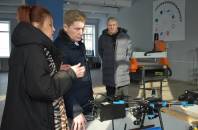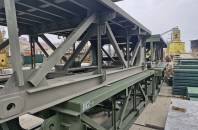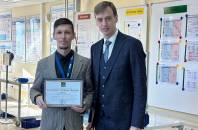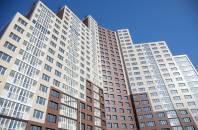|
Региональный журнал для деловых кругов Дальнего Востока
|
|
||||||||||||||||||||||
|
Вторник| 14 Октября, 21:26 |
|
|
Тема номера
|
|||||||||||||||||||||

 Олег Кожемяко осуществил новогодние желания маленьких приморцев
В преддверии новогодних праздников заветные желания маленьких приморцев начинают сбываться. Так, Губернатор Приморского края Олег Кожемяко передал подарки от Деда Мороза двум маленьким приморцам: шестилетнему Мирону Глушаку из Тернейского муниципального округа и четырёхлетней Ольге Алимпиевой из Арсеньева.
Олег Кожемяко осуществил новогодние желания маленьких приморцев
В преддверии новогодних праздников заветные желания маленьких приморцев начинают сбываться. Так, Губернатор Приморского края Олег Кожемяко передал подарки от Деда Мороза двум маленьким приморцам: шестилетнему Мирону Глушаку из Тернейского муниципального округа и четырёхлетней Ольге Алимпиевой из Арсеньева.
 Родители ребят с ОВЗ обсудили вопросы образования и трудоустройства с представителями власти Приморья
Третья встреча клуба "На равных", призванного помогать гражданам решить непростые жизненные ситуации, состоялась в Приморье. В этот день участниками клуба стали родители детей с инвалидностью и ограниченными возможностями здоровья. Они обсудили с представителями власти вопросы образования и трудоустройства таких ребят.
Родители ребят с ОВЗ обсудили вопросы образования и трудоустройства с представителями власти Приморья
Третья встреча клуба "На равных", призванного помогать гражданам решить непростые жизненные ситуации, состоялась в Приморье. В этот день участниками клуба стали родители детей с инвалидностью и ограниченными возможностями здоровья. Они обсудили с представителями власти вопросы образования и трудоустройства таких ребят.
 Социальные предприниматели Приморья могут найти кадры и получить рекламу на радио при господдержке
Открыт прием заявок на две актуальные для социальных предпринимателей меры поддержки: "Размещение двух вакансий на HeadHunter" и "Размещение рекламы на радиостанции". Такой формат господдержки поможет социальному бизнесу Приморья продвигать свои услуги в осенний период и найти профессиональные кадры для расширения штата.
Социальные предприниматели Приморья могут найти кадры и получить рекламу на радио при господдержке
Открыт прием заявок на две актуальные для социальных предпринимателей меры поддержки: "Размещение двух вакансий на HeadHunter" и "Размещение рекламы на радиостанции". Такой формат господдержки поможет социальному бизнесу Приморья продвигать свои услуги в осенний период и найти профессиональные кадры для расширения штата.
 24 протокола составили на нарушителей противопожарного режима в приморских лесах
Лесничие и инспекторы в Приморье составили 24 протокола в отношении нарушителей особого противопожарного режима на землях лесного фонда. ОПР действует в большинстве муниципалитетов и подразумевает крупные штрафы за пренебрежение правилами пожарной безопасности.
24 протокола составили на нарушителей противопожарного режима в приморских лесах
Лесничие и инспекторы в Приморье составили 24 протокола в отношении нарушителей особого противопожарного режима на землях лесного фонда. ОПР действует в большинстве муниципалитетов и подразумевает крупные штрафы за пренебрежение правилами пожарной безопасности.
Primorsky Region is poised to become a leader in economic growth
Vladimir MIKLUSHEVSKY, Governor, Primorsky Region:
Primorye’s future - a new economy
"Russia’s Primorsky Region is taking good advantage of its unique location, becoming one of the country’s most promising regions for business development. Preparation for the APEC summit has given Primorye a strong start, a solid foundation for further development.
The region is poised to pursue active integration into Asia Pacific/Pacific Rim, which is why the regional government has made creating conditions for business initiative and improving the local investment climate its top priorities.
The total cost of current investment projects in Primorye is RUB 2 trillion, including upgrades to industries that have long played a vital role in the regional economy: fisheries and fishing, agriculture, and transportation. However, Primorye’s future depends on developing new economic directions, including auto manufacturing, shipbuilding, small aircraft manufacture, gas and petrochemicals, and innovation projects. We can already see the outlines of the future shipbuilding cluster, the car manufacturing and tourism industries, the new transportation and logistics infrastructure, and the utilities sector.
Today we are at the beginning of this road, and investment, including foreign investment, will help us implement the development strategy for Primorsky Region, and raising investment is at the top of the list."
Large-scale construction is under way in Vladivostok, giving the city the look and the facilities befitting an international center, a hub of economic cooperation between Russia and other nations on the Pacific Rim.
The Russian government allocated RUB 200 billion towards infrastructure in Vladivostok from the federal budget; total investment has exceeded RUB 680 billion, and most of this was spent to make the city more comfortable for living. Residents of the Primorsky Region and visitors can see what has resulted from this. The Primorsky Region is currently 17th by social and economic development among Russian regions.
The past few years have given a boost to economic growth in Primorye. The region’s proximity to Russia’s national borders, governmental programs to enhance transportation, logistics and electric utilities infrastructure, along with improvements in the regional business climate - all of this has created significant new potential for development of private business, attracting investment, including foreign.
Primorye’s proximity to key Asia Pacific markets and its well-developed transportation and power utilities infrastructure make the region’s multi-sector economy an important contributor to the gross regional product (GRP) of the Russian Far East. In 2006-2011, the value of local GRP increased by 40%, while industrial output expanded by 60%; foreign trade doubled, and investment in fixed assets increased by a factor of 4.7x.
GRP expanded by 7% in 2011 year-on-year, which was in line with the growth rates of the strongest economies of Asia Pacific - China, South Korea and Japan. The regional economy and social sphere saw RUB 278.4 billion in investment in 2011, a 21.3% year-on-year increase. Private investment accounted for more than half of the total - RUB 181.4 billion, making it possible to describe Primorye as attractive for investors. The Expert RA rating agency corroborates this conclusion, ranking the Primorsky Region in 22nd among Russia’s 83 regions in terms of investment appeal.
Objective: diversification
Diversification of the Primorsky economy is the number one priority, as for all regions of the RFE. The regional development strategy provides for implementation of new, sometimes one-of-a-kind projects based on innovative technologies. Some of the larger projects are in shipbuilding, auto manufacturing, and petrochemicals, transportation and electric utilities. The region has the potential for setting up new facilities in other industries, including IT, pharmaceuticals and healthcare. This does not include the long-overdue upgrades of facilities in industries traditional for Primorsky Region.
The ultimate goal of this strategy is increasing government revenue, raising the standard of living for residents of the region, and attracting new labor resources to the region. As many as 69 investment projects aligned with the region’s strategic goals are currently being implemented, with a total cost of more than USD 100 billion, and a number of new large investment projects may be started in the region over the next several years.
The objectives are challenging and will require significant investment. This is why the Primorsky Regional government has defined investment priorities in six areas.
The Primorsky Region is looking at new opportunities associated with creating a gas and petrochemical cluster in the region, one of six in Russia. These opportunities involve delivering hydrocarbons across the region to regional ports. Associated projects are already under way.
Rosneft is building one of Russia’s and the world’s largest petrochemicals complexes in Primorsky Region that will produce around 10 million tons of petroleum products with refining depth of 95% or higher. The plant will produce pyrolysis products, monoethylene glycol, polyethylene, polypropylene, and alpha-olefines. The total cost of the project is estimated at RUB 173,2 billion.
Gazprom is planning to start construction of a gas pipeline to connect Yakutia to Khabarovsk and Vladivostok and to build several natural gas processing and liquefaction plants in southern Primorye with a total estimated cost of RUB 500 billion. Construction of an LNG plant would make it easier to ship gas to the domestic market and Asia Pacific countries, as LNG can be exported by sea anywhere in the world.
Another investment target in the Primorsky Region designed to enhance the region’s competitiveness is development of transportation and logistics hubs with intermodal capabilities to serve Russia’s foreign trade and international transit flows of passengers and cargo. This has given Primorye’s ports a new lease on life, opening up new transcontinental transportation corridors. The new Vladivostok International Airport at Knevichi was built with this in mind and should become Russia’s link in international air traffic in Asia Pacific.
Creating a shipbuilding cluster in Primorye is an important avenue for developing the regional economy. Daewoo Shipbuilding and Marine Engineering (DSМЕ) is helping to construct a new shipyard based on the facilities of Zvezda in Bolshoy Kamen capable of building large ice-reinforced tankers displacing up to 250,000 tons. The Far Eastern Shipbuilding and Ship Repair Center, a division of the Russian state-owned United Shipbuilding Corporation, is a major investor in the project. The first stage of the new shipyard is expected to come on line by end-2012, followed by the other stages coming online every two years through 2018.
A little further south, in the Bay of Five Hunters, construction of the specialized Vostok Raffles JV Shipyard is beginning in cooperation with the Singaporean-Chinese Yantai Raffles Shipyard; the shipyard will have a Taisoon II 40,000-ton lifting complex installed, making it possible to build oil platforms for shelf oil and gas projects.
Traditional “old-economy” sectors (agriculture, timber and lumber, fishing and fisheries), as well as electric utilities are undergoing active upgrades. The Primorsky Regional government is placing special emphasis on developing green technologies which can provide exports to Asia Pacific/Pacific Rim. The region is supporting projects that rely on innovation to develop agriculture, aiming to produce organic food and ensure a secure, independent food supply for the Primorsky Region, projects that address the vital issue of reducing food prices. Several cattle farms are currently under construction in the region, at an overall cost of RUB 4.5 billion.
In the electric utilities sector investors are invited to consider projects for construction of a natural gas-burning Nakhodka heat and electricity generator (TEC) and a brown coal-burning Ussuriisk TEC, with a combined approximate cost of RUB 40 billion. The new power plants would provide electricity for new production facilities and companies in the hydrocarbon transportation and deep refining segments, as well as ensuring reliable power supply to consumer in the southern Primorye. Foreign investors are expected to become involved in these projects.
Development and implementation of innovations is an especially promising area. The Primorsky Region has significant potential for high-tech production facilities in such sectors as pharmaceuticals, health care and IT and communications technology. The region is developing a high-tech research and technology park to make the Primorsky Region an international center for innovative technology in the RFE, help realize the potential of developing high-tech facilities and businesses, and enter the international market for innovative products.
Completing the construction of Far Eastern Federal University (FEFU) will provide a solid foundation for this project. By 2025, the university is expected to have approximately 50,000 students from Russia and Asia Pacific/Pacific Rim, with the best professors and scientists teaching there. FEFU will provide training for skilled specialists for an innovative economy and for expanding international cooperation in the areas of research and technology.
Primorsky Region as a tourist destination
Development of tourism is an important priority for enhancing the Primorsky Region’s new image, with various large projects under way: construction of an integrated entertainment zone on the basis of the Primorsky Gambling Zone in Muravyinaya Bay, less than half-an-hour’s drive from the airport. The amount of required investment is estimated at RUB 55 billion at the very least.
Experts believe that the region’s unique ecology and proximity to other Asia Pacific nations would make the Primorsky Integrated Entertainment Zone one of the most appealing projects for investors. The Primorsky Gambling Zone project envisages construction of 16 hotels of different levels of comfort and luxury, as well as a casino, a yacht club marina, a downhill ski slope, a shopping and exhibition center, guest villas, promenades, parks and beaches. Even at this early stage, US, Chinese, Singapore and Malaysian investors have shown interest in the project. Las Vegas-based Galaviz & Co. has been brought in to handle concepts targeting prospective investors. If the Primorsky Integrated Entertainment Zone is developed and promoted effectively, it can bring as many as eight million visitors (domestic and international) per annum. Implementation of the project, which is scheduled for completion by 2022, has already started. A hotel complex and casino are already under construction at Muravyinaya Bay.
Preparation for hosting the APEC summit has helped to build world-class modern business infrastructure in Vladivostok that can accommodate high-profile international events. This could make Vladivostok, alongside Moscow, St. Petersburg, and Sochi one of the top host cities for large international events and for the Meetings, Incentives, Conferencing, Exhibitions segment of business tourism.
Creating a balmy investment climate
Forbes Magazine ranks the Primorsky Region as the best RFE region to do business in. The Primorsky Region has approximately USD 600 million of foreign investment working in its economy.
There are currently about 400 businesses with foreign capital in their capital structure in the region, and as many as 2,000 international firms and companies, and companies with foreign capital work in the region. These include local offices of major international brands: Siemens (Germany), Yantai Raffles (Singapore), Nycomed Pharma (Norway), Ssang Yong, Sumotori, Lotte, Hyundai (South Korea), SKF (Sweden), Mazda, Komatsu (Japan) and others.
Successful projects by foreign investors have been implemented in various sectors of the Primorsky economy. Sumitomo has helped Terney Les timber and lumber processor put into operation the STS Technowood and PTS Hardwood factories to ship decorative wood panels and laminated panels to Japan for use in housing construction. Russia’s SOLLERS and South Korea’s Ssang Yong launched assembly of Ssang Yong SUVs in Vladivostok in December 2009, investing RUB 2.3 billion in the project. The project included building two assembly lines, a testing facility and a warehousing terminal. Two more projects are to be launched at the SOLLERS - Russian Far East site: a joint project with Japanese Mitsui to produce Toyota LC Prado SUVs and a project with Mazda to set up a joint venture to produce new Mazda vehicles - the CX5 crossover and a С/D class sedan. This would make it possible to create a new automaking cluster in the Primorsky Region with annual capacity of 100,000 cars and car parts, with some output potentially exported to Asia Pacific countries.
A range of targeted programs help to improve the business climate and create better conditions for attracting investment in the Primorsky Region. Key programs are For Investment Climate Improvement, For Developing Small and Medium-Sized Business and For Promoting Competition in the Primorsky Region. The regional legislature of the Primorsky Region is working to improve the regional laws regulating investment; among other things, it is working on a private-public partnership bill and an investment tax incentives bill. The regional government is working on a document that would remove administrative barriers to starting and running a business; the document would also reduce the associated costs of time and money.
New institutions for investors are being created in the region, including the Primorsky Regional Governor’s Council for Attracting Investment, the Investment Agency with the key function to write business plans for potentially promising projects and provide ready-to-build sites to investors. Every investor in the region receives personal treatment. Funds from Russian financial institutions are raised as co-financing guarantees for foreign investment in private projects. State-owned VEB and the Russian Far East and Baikal Region Development Fund are reviewing approximately 20 investment projects in the Primorsky Region worth more than RUB 390 billion.
Work is under way in Primorye to draft a new five-year social and economic development program that would include a map of integrated investment projects categorized by location and industry. The program would become an action plan for administrators at various levels and for prospective investors.
Government of the Primorsky Region
Department of Economics, Business Support, Development of Competition, Investment and Oversight of Preparations for the APEC Summit
Tel: (423) 220-92-34E-mail: depeconomy@primorsky.ru
- Дальневосточный фокус. Как делать бизнес на Дальнем Востоке?
- Дрейф в штиль. Куда идет дальневосточный бизнес
- Акцент на береговую зону
- "РЖД" берет повышенный план
- Банки сняли отраслевые барьеры малому бизнесу на Дальнем Востоке
- Рейтинг 100 крупнейших компаний Дальнего Востока по выручке и темпам роста показывает реальные дела
- Рецепты выживания: Рейтинг эффективности бизнеса 100 крупнейших компаний Дальнего Востока
- По "Улице Дальнего Востока" с любопытством и восторгом
- Проект "Приморский маршрут": Приморский край: есть чем впечатлиться
- ТОП крупнейших компаний Дальнего Востока расширился до 150
 #ПозывнойКультура: Дед Мороз поздравил участников СВО в госпитале ТОФ с наступающим Новым годом
В преддверии Нового года агитбригада #ПозывнойКультура побывала в госпитале Тихоокеанского флота в субботу, 28 декабря. Для участников СВО, находящихся на лечении и реабилитации, прозвучали музыкальные поздравления. Со словами самых теплых пожеланий подарки военнослужащим вручила заместитель Председателя Правительства Приморского края – министр культуры и архивного дела Елена Бронникова.
#ПозывнойКультура: Дед Мороз поздравил участников СВО в госпитале ТОФ с наступающим Новым годом
В преддверии Нового года агитбригада #ПозывнойКультура побывала в госпитале Тихоокеанского флота в субботу, 28 декабря. Для участников СВО, находящихся на лечении и реабилитации, прозвучали музыкальные поздравления. Со словами самых теплых пожеланий подарки военнослужащим вручила заместитель Председателя Правительства Приморского края – министр культуры и архивного дела Елена Бронникова.
 Губернатор Приморья оценил оснащение Индустриального колледжа в Арсеньеве
Очередной день работы Губернатора Приморского края Олега Кожемяко в муниципалитетах региона начался с посещения Приморского индустриального колледжа в Арсеньеве. Глава региона изучил новое оборудование, на котором готовят специалистов технических специальностей.
Губернатор Приморья оценил оснащение Индустриального колледжа в Арсеньеве
Очередной день работы Губернатора Приморского края Олега Кожемяко в муниципалитетах региона начался с посещения Приморского индустриального колледжа в Арсеньеве. Глава региона изучил новое оборудование, на котором готовят специалистов технических специальностей.
 Комплекты быстровозводимых мостов начали поставлять в Приморье
Началась поставка средних автодорожных разборных мостов (САРМ) для проведения аварийно-восстановительных работ на дорогах Приморья. Всего на следующий год закуплено 11 комплектов. При необходимости комплекты САРМ будут использованы для оперативного восстановления проездов во время паводков.
Комплекты быстровозводимых мостов начали поставлять в Приморье
Началась поставка средних автодорожных разборных мостов (САРМ) для проведения аварийно-восстановительных работ на дорогах Приморья. Всего на следующий год закуплено 11 комплектов. При необходимости комплекты САРМ будут использованы для оперативного восстановления проездов во время паводков.
 Почти 900 сотрудников предприятий Приморья уже владеют бережливыми технологиями благодаря нацпроекту "Производительность труда"
Итоги реализации национального проекта "Производительность труда" и планы на будущее озвучил министр экономического развития Приморья Андрей Блохин на награждении команды Регионального центра компетенций. За четыре года работы нацпроекта реализовано 78 проектов по внедрению бережливых технологий на предприятиях края.
Почти 900 сотрудников предприятий Приморья уже владеют бережливыми технологиями благодаря нацпроекту "Производительность труда"
Итоги реализации национального проекта "Производительность труда" и планы на будущее озвучил министр экономического развития Приморья Андрей Блохин на награждении команды Регионального центра компетенций. За четыре года работы нацпроекта реализовано 78 проектов по внедрению бережливых технологий на предприятиях края.


